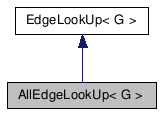AllEdgeLookUp< G > Class Template Reference
[Graph Maps, Basic Graph Utilities]
Detailed Description
template<class G>
class lemon::AllEdgeLookUp< G >
This class is the same as EdgeLookUp, with the addition that it makes it possible to find all edges between given endpoints.
- Warning:
- This class is static, so you should refresh() (or at least refresh(Node)) this data structure whenever the graph changes. This is a time consuming (superlinearly proportional (O(mlogm)) to the number of edges).
- Parameters:
-
G The type of the underlying graph.
- See also:
- DynEdgeLookUp
#include <lemon/graph_utils.h>
Inheritance diagram for AllEdgeLookUp< G >:

Public Member Functions | |
| AllEdgeLookUp (const Graph &g) | |
| Constructor. | |
| void | refresh (Node n) |
| Refresh the data structure at a node. | |
| void | refresh () |
| Refresh the full data structure. | |
| Edge | operator() (Node s, Node t, Edge prev=INVALID) const |
| Find an edge between two nodes. | |
Constructor & Destructor Documentation
| AllEdgeLookUp | ( | const Graph & | g | ) | [inline] |
Constructor.
It builds up the search database, which remains valid until the graph changes.
Member Function Documentation
| void refresh | ( | Node | n | ) | [inline] |
Build up the search database of node n.
It runs in time O(dlogd), where d is the number of the outgoing edges of n.
Reimplemented from EdgeLookUp< G >.
| void refresh | ( | ) | [inline] |
Build up the full search database. In fact, it simply calls refresh(n) for each node n.
It runs in time O(mlogD), where m is the number of the edges of n and D is the maximum out-degree of the graph.
Reimplemented from EdgeLookUp< G >.
| Edge operator() | ( | Node | s, | |
| Node | t, | |||
| Edge | prev = INVALID | |||
| ) | const [inline] |
Find an edge between two nodes.
- Parameters:
-
s The source node t The target node prev The previous edge between sandt. It it is INVALID or not given, the operator finds the first appropriate edge.
- Returns:
- An edge from
stotafterprevor INVALID if there is no more.
u to v in the following way. AllEdgeLookUp<ListGraph> ae(g);
...
int n=0;
for(Edge e=ae(u,v);e!=INVALID;e=ae(u,v,e)) n++;
Finding the first edge take O(logd) time, where d is the number of outgoing edges of s. Then, the consecutive edges are found in constant time.
- Warning:
- If you change the graph, refresh() must be called before using this operator. If you change the outgoing edges of a single node
n, then refresh(n) is enough.
 1.5.9
1.5.9